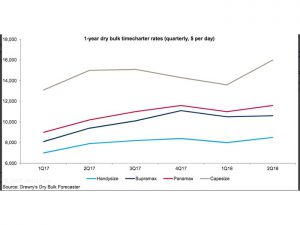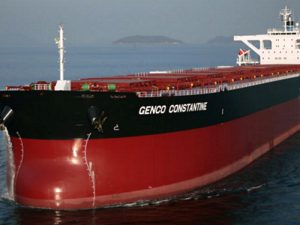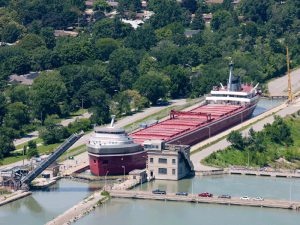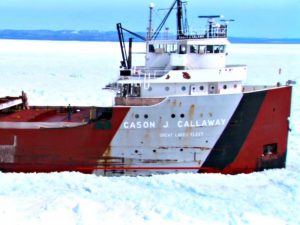The Great Lakes – St. Lawrence Seaway is one of the largest trade corridors in the world, spanning over 2,300 miles from the Gulf of St. Lawrence to Lake Superior. The system—primarily used for the shipping of traditional and new cargoes, such as mining products, steel, iron ore, dry bulk and grain—has an economic output of nearly $5 trillion, it sustains over 220,000 jobs in both Canada and the U.S.; produces $34 billion in business revenues and $3.6 billion in transportation cost savings; and provides competitive shipping and direct access to America’s heartland.
But anyone reading the latest trade reports coming out of the region would not be at fault for thinking the market is in a downturn. Sluggish traffic and a slide in iron ore cargoes for the steel industry and limestone shipments for the construction market grabbed the headlines in the local papers last month.
For the month of July, shipments of iron ore on the Great Lakes and St. Lawrence Seaway decreased by 15 percent when compared to July 2015 numbers. According to the Lake Carrier’s Association, which represents 14 American companies operating 56 U.S.-flag vessels on the Great Lakes, shipments were also down by more than 18% compared to the five-year average.
The Association went on to say that shipments from U.S. ports totaled 4.95 million tons in July, a decrease of nearly 14 percent compared to a year ago. Loadings at Canadian terminals dipped 23 percent to 643,000 tons. Year-to-date, the iron ore trade stands at 26.8 million tons, a decrease of 3 percent compared to the same period in 2015. Moreover, year-over-year, loadings at U.S. ports are down by 113,000 tons, while loadings from Canadian ports in the St. Lawrence Seaway are down 743,000 tons (21 percent).
Limestone didn’t fair any better. Shipments on the Great Lakes totaled 3,348,040 tons in July—a decrease of 18 percent compared to a year ago, and July loadings were down 14 percent below the month’s five-year average.
“We are about half-way through the 2016 navigation season and our overall cargo tonnage numbers are down by 11 percent,” says Betty Sutton, Administrator of the Saint Lawrence Seaway Development Corporation.
According to the Saint Lawrence Seaway Development Corporation, year-to-date cargo shipment from March 21, 2016 to July 31, 2016 were down 11 percent over the same period in 2015. The dry bulk category was down 13.4 percent (however, stone and potash were up), iron ore was down 28 percent and coal was down almost 13 percent.
The news isn’t all doom and gloom for commodities, however. “The lack of iron ore and coal has definitely been a contributing factor for this decrease; however traffic continues to be well above the five-year average, keeping our ports and their workforce busy,” says Sutton.
They don’t call the system the “Opportunity Belt” for nothing.
Ports in Minnesota and Ohio are in high demand through the push of agricultural products, such as corn and wheat. Meanwhile, ports in Chicago, Indiana and Wisconsin are benefiting from the movement of steel products and machinery, explains Sutton. Between March and July of this year, steel slabs, which would be categorized under general cargo, were up 214 percent over the same period in 2015, while other general cargo was up 74 percent.
The Port of Cleveland, for instance, has “seen steady growth” in month-to-month tonnage numbers during the 2016 season, says David S. Gutheil, Vice President, Maritime and Logistics. The rise in tonnage, goes hand-in-hand with the success of the Port’s Cleveland-Europe Express liner service. The service, launched by the port in 2014 with vessel partner the Spliethoff Group, directly moves cargo between the Great Lakes and Europe, offering customers savings on inland transits and shorter transit times between the U.S. and Europe.
Gutheil adds, that the Port is seeing “steady volumes of imported steel from Europe,” and an “increased interest in the project cargo market” from customers with a vested interest in moving cargo through the St. Lawrence Seaway.
To that end, the Port of Cleveland has invested in, and recently completed, the “construction of a new 21,000 square foot warehouse. This new facility,” explains Gutheil, was “partially funded through a grant secured through the Ohio Department of Development Logistics program, will be used for trans-load opportunities and increases our inside storage capacity to 320,000 square feet.”
The new warehouse is part of the Port’s ongoing infrastructure investment plan. Earlier this year, the Port commissioned two Liebherr 280 mobile harbor cranes. The cranes are expected to significantly increase the Port’s speed and efficiency.
Beyond the shipping of commodities, ports in the region are also seeing an uptick in tourism—leading to a proliferation in expansions and infrastructure investments.
Resurgence in cruise shipping
“In a time when the world’s industrial giants and cruise ships are all landing in the ports of the St. Lawrence, we have to utilize the strategic location of the Port of Québec to make it the marine destination of choice,” says Mario Girard, President and CEO of the Port of Québec. The deepwater port of the Port of Québec, which sits at the end of the St. Lawrence-Great Lakes trade route, is seeking to rebuild and enhance a number of areas around the port in the hopes of increasing both foot and vessel traffic. But the area likely to get the most buzz will be the expansion of the port’s cruise terminal.
With a resurgence in the cruise market in the Great Lakes region, ports such as the Port of Québec are looking to capitalize on the market, making large infrastructure investments to help meet growing vessel and passenger demand.
Over the last decade, the Port of Québec has seen cruise ship visitor numbers increase—from 55,000 in 2000 to 180,000 in 2014. Operating at full capacity, the Port of Québec will oversee a redesign and expansion of the Ross Gandreault Cruise Terminal and the installation of a mobile terminal at wharf 30 in the Estuary sector.
The hope is that the expansion, which will double the accommodation capacity at the Ross Gaudreault terminal and make way for larger ships, will enable the growth of the cruise market sector to continue, with the port capable of accommodating 400,000 passengers a year by 2025.
The $89.5 million project, called “Québec, A Destination of Choice of the St. Lawrence” will be completed over the next decade.
Meanwhile, over at Port Saint John, the second largest port by tonnage in Canada, cruise activity is expected to increase by 20% this year, with 64 ships calling at the port, bringing in 144,000 passengers and 57,700 crew members to the region, before the season’s end October 28th 2016. Cruise activity at the port represents a $25 million annual boost to New Brunswick’s economy.
Beyond the cruise sector, Port Saint John’s expansion is being driven by a steady increase in containerized cargo. Catering to a diverse cargo base, which includes dry and liquid bulk, break bulk, containers and cruise ships, the traditionally smaller container port is modernizing its facilities to maintain and support increases in both trade and business.
The port’s $205 million, seven-year, West Side Modernization Project—funded by the port, the Canadian federal government and the government of New Brunswick in three equal parts ($68.3 million each)—will see the upgrading and consolidation of the Rodney and Navy Island terminals, enabling the accommodation of larger vessels; and the installation of new operating systems and technology to help enhance cargo-handling capabilities.
Port Saint John says the project, which is slated for completion in seven years, builds on Canada’s commitment to drive economic growth in Atlantic Canada through trade and investment.
Linking the past and future
The Port of Montreal is in the midst of its latest modernization project. The port, which supports 16,000 jobs, generates $2.1 billion in economic spin-offs annually, and in 2015 handled 32 million tonnes of cargo and welcomed 91,000 cruise passengers and crew, will revamp its aging Alexandra Pier and Iberville Passenger Terminal. While the restoration is taking place, passengers will be welcomed at alternative cruise ship terminals, berths 34-35 and 36-37, located east of the Jacques-Cartier Bridge.
The goal is to have a majority of the project done in time to celebrate the 375th anniversary of the City of Montreal’s founding next year. The restoration project is intended to help integrate the pier and terminal into the urban fabric of Old Montreal, provide better access to the St. Lawrence river, and improve conditions to help meet growing cruise ship passenger demand.
“The Port of Montreal is a real treasure for the city, and remains one of our main economic assets,” says Montreal Mayor Denis Coderre. “The restored facilities of Alexandra Pier and Iberville Passenger Terminal will let us extend a magnificent welcome to the tourists and visitors who will come celebrate Montreal’s 375th anniversary with us in 2017.”
The total cost of the project is estimated at $78 million—with the Government of Quebec providing $20 million in funds through the Maritime Strategy – Tourism Component, and the City of Montreal providing an additional $15 million.
The project will include the reconstruction of the ground floor of the passenger terminal, construction of a new observation tower (its completion is expected in 2019), the lowering of the pier and installation of a public place, implementation of a port center, an upgrade to the parking area on the side of the secondary terminal, the addition of a green rooftop terrace, and the introduction of a main access entrance to the pier, further integrating the terminal into the surrounding area.




